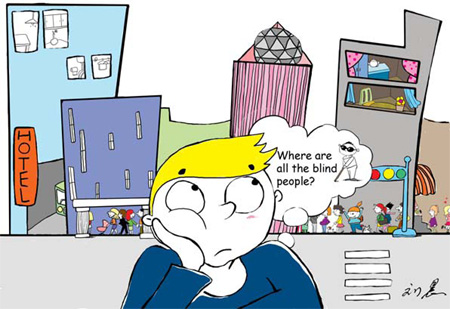
|
Metro> Comment
 |
|
Blind leading the blind
By Luke Holden (China Daily)
Updated: 2009-11-25 11:14 You don't have to be blind to not see blind people in Beijing. The government appears to have spent a tidy sum making bumpy journeys throughout the city but witnessing them being used is bizarrely rare. I have lived in Beijing for five years now and not once have I seen a blind person walking on the street. Worse than that, I didn't even question it, until now.
 A thought immediately struck my mind; how many blind people live in this city? A quick call to the Beijing disabled person's center revealed that a national survey conducted in 2006 put the figure at 67,000. Naturally, I tend to treat such statistics with caution and sought external confirmation.
So if the numbers are right, where are they and what are they doing? Some are working. Back in 2006, the government put into action a plan to increase the number of blind therapists by 50,000 to 140,000 nationwide. Not exactly a great chunk of the estimated 12 million, but useful nonetheless. And a handful of blind people are sometimes seen begging on the subways, usually led by disabled or elderly partners. Life can be unfairly hard, but Beijing does at least offer some form of respite for trapped souls. The BBC World Service Trust runs a radio station for visually impaired people called In Touch for China. Using a team of six visually impaired Chinese radio producers and journalists, it broadcasts on local radio stations throughout China, covering topics of health care and education as well as problems and solutions relating to mobility. But again, if there are 67,000 blind people benefiting from a radio station that helps them get mobile, why aren't I seeing them on the street? As it turns out, answering that question was rather easy. Using blind pathways, I walked the 15-minute journey from my office to the subway station. In that short distance alone I found no less than 9 obstacles blocking my journey, from parked cars to glass doors. Luckily for me, I didn't need to navigate the busy intersection because the angle of approach would have taken me right into the center of the chaos. In short, those paths are dangerously unreliable. Walking down the subway stairs, I then noticed the Braille system on the handrail. China uses two Braille systems; a well-structured system based on pinyin but lacking tones, and a newer, simpler version with tones included. Guess which one the subway uses. So where are all the blind people in Beijing? Quite honestly I don't know. I do know however that the city has failed to provide a safe environment to match the pedestrian needs of blind people, while at the same time opened its roads to a staggering 4 million cars. In my mind at least, memories of the Paralympics have long since faded.
|
|||||||